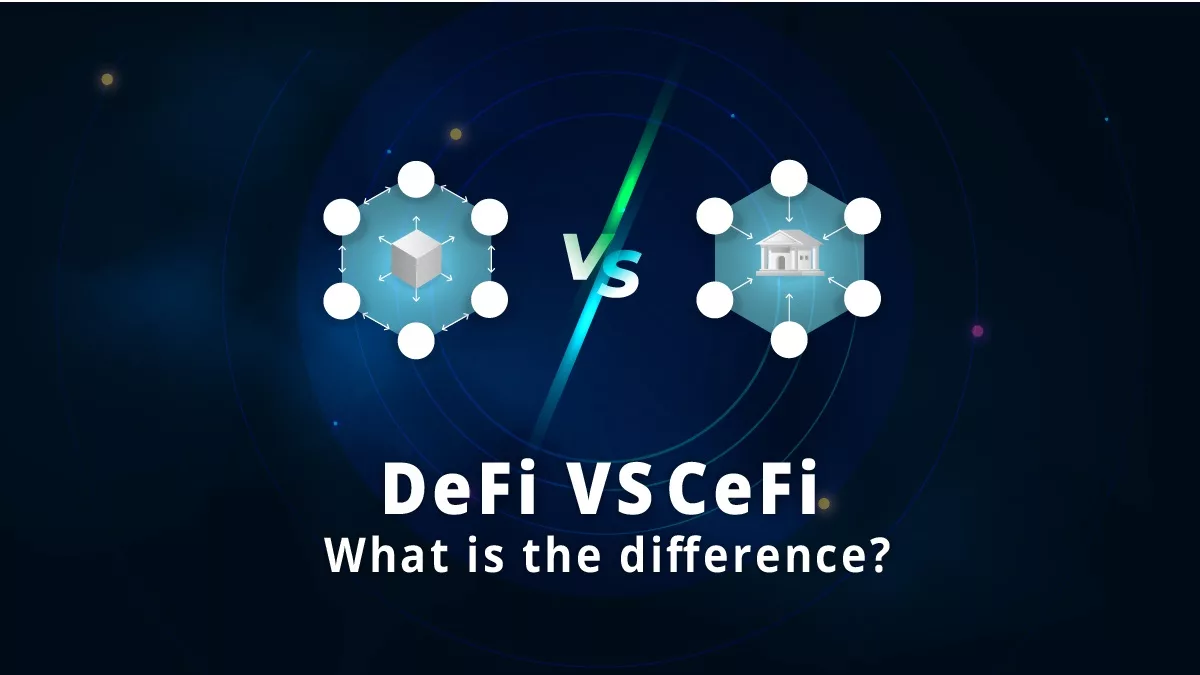When we step into the world of digital currencies, first, we have to choose which type of financial market to invest in: centralized finance(CeFi) or decentralized finance (DeFi). In this article, we have defined both types of markets. After reading this article, you will be able to make a better choice between CeFi vs DeFi with a more open view. So stay with us.

What is CeFi?
CeFi stands for Centralized Finance, which refers to traditional financial systems and services that are centralized and operate through intermediaries such as banks, financial institutions, and other centralized entities.
It’s like when you use a regular bank for transactions or services.
The creation of cryptocurrency exchanges followed the emergence of cryptocurrencies, particularly with the introduction of Bitcoin in 2009. After the creation of cryptocurrencies, a similar model like centralized financial systems came, and exchanges were created that provided the possibility of cryptocurrency transactions and investments in a centralized manner like a bank. So, just like traditional finance, in CeFi, there is an intermediary platform called a Centralized Cryptocurrency Exchange (CEX) where you can deposit your assets and use the services they offer. We can mention Binance, Coinbase, Kraken, Bitfinex, and Bittrex, to name a few centralized exchanges. For instance, Binance offers a variety of services in the cryptocurrency space. Some of the services provided by Binance include Spot Trading, Futures and Derivatives Trading, Staking, Savings, Binance Launchpad (Token Launch Platform), Binance Academy (Educational Platform), Binance Visa Card, Peer-to-Peer (P2P) Trading, Binance Smart Chain (Blockchain Platform), Binance Coin (BNB).

Here are some key characteristics and components of CeFi:
Centralization
CeFi is characterized by a central authority or intermediary that facilitates financial transactions, manages user funds, and provides various financial services.
Intermediaries
Transactions on CeFi platforms often involve intermediaries and clearinghouses that facilitate and verify the transactions. These intermediaries act as trusted third parties in the financial process.
Traditional Infrastructure
CeFi platforms typically use traditional financial infrastructure and technologies, including databases. CeFi platforms use centralized databases to store and manage user information, account balances, and transaction history. These databases are controlled and maintained by the central authority.
Traditional Financial Instruments
CeFi offers various traditional financial instruments and services, including savings accounts, loans, credit cards, investment products, and more.
Regulatory Compliance
CeFi platforms typically operate within existing regulatory frameworks and comply with financial regulations. They are subject to oversight and supervision by government authorities. Many CeFi institutions operate under specific licenses or charters granted by regulatory authorities. This formalizes their status as authorized financial entities.
Familiarity and Accessibility
CeFi services are often more familiar to the general public as they resemble traditional banking and financial systems. The user interface and processes are designed for ease of use and accessibility.
Customer Support
CeFi platforms commonly provide customer support services to assist users with account-related inquiries, issue resolution, and other customer service needs.
Security Measures
CeFi platforms implement security measures to safeguard user funds and sensitive information. These measures may include encryption, identity verification, and fraud detection mechanisms.
Integration with Legacy Systems
CeFi platforms are often integrated with existing financial infrastructure and legacy systems. This integration allows for compatibility with established financial networks and services.
KYC (Know Your Customer) is required
Another main characteristic of CeFi is the KYC. Users should be authenticated through sign-up forms. They should submit their photo, address, mobile, and other information.
It’s important to note that while CeFi provides certain advantages regarding familiarity and regulatory compliance, it also comes with potential drawbacks, such as central points of failure, limited transparency, and reliance on a centralized authority.

CeFi Challenges and Risks:
Centralized Finance (CeFi) has its set of challenges, which has led to the rise and popularity of Decentralized Finance (DeFi) platforms like CrowdSwap. Here are some common problems associated with CeFi:
Single Point of Failure
CeFi relies on centralized entities like banks or financial institutions, which can be vulnerable to system failures, hacks, or even regulatory issues. If a central authority experiences a problem, it can disrupt the entire financial system connected to it.
Limited Accessibility
Traditional financial systems may not be accessible to everyone, especially in regions with poor banking infrastructure or where individuals lack the necessary documentation. This exclusionary nature prevents some people from participating in financial activities. For instance, citizens of certain countries face restrictions or challenges in opening accounts and engaging in cryptocurrency transactions on various reputable crypto exchanges.
Slow Transactions
CeFi transactions often involve multiple intermediaries and verification steps, leading to delays. Cross-border transactions, in particular, can take a considerable amount of time due to the involvement of different financial institutions.
High Fees
Centralized intermediaries typically charge fees for their services, including transaction fees, account maintenance fees, etc. These fees can add up, especially for frequent or international transactions, reducing the overall value for users.
Lack of Transparency
CeFi systems are not always transparent about their operations, and users may have limited visibility into how their funds are managed. This lack of transparency can erode trust among users.
Censorship and Control
Centralized entities have the power to control and censor transactions, freeze accounts, or restrict access based on various factors. This goes against the principles of financial freedom and autonomy.
Privacy Concerns
CeFi often involves collecting and storing user data, raising privacy concerns. Users may be uncomfortable with the idea of their financial information being held by a single central authority.
Dependence on the Regulatory Environment
CeFi platforms are subject to regulatory oversight, and regulation changes can impact their operations. Users may face uncertainties and risks associated with evolving regulatory environments.
By addressing these issues, decentralized platforms like CrowdSwap aim to offer users a more transparent, accessible, and resilient alternative to traditional centralized financial systems.

What is DeFi?
DeFi stands for Decentralized Finance. DeFi aims to provide various financial services in a peer-to-peer format without traditional intermediaries. DeFi leverages blockchain technology and smart contracts to enable direct interactions between users, allowing them to lend, borrow, trade, and participate in various financial activities without relying on centralized institutions like banks. The goal is to create a more open, accessible, and inclusive financial system.
Imagine you want to borrow or lend money, trade digital currencies, or earn interest on your savings. In DeFi, you can do all these things without needing a bank. (Except the first time buying a crypto) Everything happens automatically through smart contracts on the blockchain; everyone can see what’s happening because it’s transparent. Let’s review an example of borrowing and lending:
Borrowing: Users can borrow funds by collateralizing their cryptocurrency assets. A smart contract is a self-executing computer program with code that defines and automatically enforces the terms of an agreement or contract. Smart contracts automatically execute and manage the loan terms, including interest rates and collateral requirements.
Lending: Users can lend their cryptocurrency assets and earn interest. Smart contracts automate the lending process, distributing interest payments directly to lenders.
So, DeFi is about making financial activities like borrowing, lending, and trading more open, accessible, and controlled by the people using it rather than a central authority. It’s like a financial system that’s more like peer-to-peer, where individuals interact directly without the need for traditional intermediaries.

Here are some key characteristics and components of DeFi:
Decentralization
DeFi operates on decentralized networks, usually utilizing blockchain technology. This means there’s no central authority governing or controlling the financial activities.
Smart Contracts
Smart contracts are self-executing contracts with the terms of the agreement directly written into code. In DeFi, smart contracts automate and enforce the terms of various financial transactions, reducing the need for intermediaries.
Read more: What is a smart contract?
Direct Control over assets
Unlike traditional finance, where individuals rely on banks and exchanges as custodians of their funds, DeFi operates on blockchain technology and smart contracts, allowing users to have direct control over their assets. In DeFi, users retain ownership of their private keys, granting them sole access and authority over their funds. This eliminates the need for trust in centralized entities, mitigating the risk of potential issues like bank failures or exchange hacks. The decentralized nature of DeFi empowers individuals with greater financial autonomy and security, aligning with the core principles of blockchain technology.
Tokenization
Many DeFi projects involve the use of tokens, which represent various assets like cryptocurrencies, real-world assets, or even ownership in a particular protocol. Tokenization enables the creation of diverse financial instruments.
Interoperability
DeFi platforms often aim for interoperability, allowing different protocols to work together seamlessly. This interconnectedness enhances the overall efficiency and functionality of the DeFi ecosystem.
Limitless exchange
You can start from less than $1 and swap as much crypto as you want – there is no upper limit.
It’s important to note that while DeFi has introduced innovative and financial solutions, it is still a rapidly evolving space with its own set of challenges and risks. Users should exercise caution, conduct due diligence, and be aware of the aspects of DeFi when participating in these activities.

DeFi Challenges and Risks:
Smart Contract Risks
DeFi relies heavily on smart contracts, which are self-executing contracts with code governing their terms. However, vulnerabilities or bugs in smart contracts can lead to security breaches, hacks, and financial losses.
Security Concerns
Imagine a safe where you keep your money. DeFi platforms are like digital safes, and if the locks (smart contracts) are not super strong, bad actors might find a way in and take money.
DeFi platforms and protocols are susceptible to security threats, including hacking attempts, phishing attacks, and exploits. The decentralized and open nature of DeFi can make it a target for malicious actors. The identity of people is not known in DeFi, so it is not possible to track where the money goes if a hack happens.
Regulatory Uncertainty
Imagine playing a game where the rules keep changing. DeFi is like that sometimes. It operates in a space with unclear rules, and new rules might make it confusing.
DeFi operates in a regulatory gray area in many jurisdictions. Evolving regulations could impact the legality and operation of DeFi platforms. Regulatory uncertainty may also limit the adoption of DeFi by institutional players.
User Experience
The user interfaces of some DeFi platforms may be complex and challenging for non-technical users. Improving the overall user experience is crucial for wider adoption, but in the Crowd Swap app, an effort has been made to simplify the user’s operations by removing complications and additional processes. This app has a very simple and understandable user interface.
Scalability Issues
Some DeFi platforms, particularly those built on popular blockchains like Ethereum, face scalability challenges. High transaction fees and network congestion can limit the scalability and efficiency of DeFi applications.
Cross-Chain Interoperability
DeFi protocols built on different blockchains may face challenges in interoperability. Establishing seamless communication and interaction between different blockchain networks is a complex task, but in the CrowdSwap app, this is easily possible.
For example, in the CrowdSwap app, CROWD is an intermediary in some cross-chain transactions. This helps to make and receive the correct output and increases the transaction’s security.
On the other hand, CrowdSwap offers a good price, especially in transactions where CROWD acts as an intermediary. Also, the speed of transactions in CrowdSwap is favorable.
Educational Barriers
Understanding how DeFi works and using different protocols can be challenging for newcomers. Educational barriers may slow adoption, and users need a good understanding of the risks involved.
These challenges are like obstacles in a game. Despite these challenges, the DeFi ecosystem continues to evolve, and many projects are actively working on addressing these issues to improve the overall stability, security, and accessibility of decentralized financial services.
If you want to read more about DeFi systems, we suggest you read “What is DeFi? All you need to know about Decentralised Finance” and “10 Things to Avoid While Using DeFi Services” articles.

CeFi vs DeFi
The table below briefly compares the different features of CeFi vs DeFi. This quick-reference table outlines the essential differences between CeFi vs DeFi. Whether you’re new to the space or a seasoned investor, this straightforward comparison helps you navigate the key aspects of CeFi and DeFi, making informed choices in your financial journey.
| Feature | CeFi | DeFi |
| Control | Centralized control by financial entities | Decentralized control by users and smart contracts |
| Intermediaries | Relies on intermediaries like banks and financial institutions | Minimizes intermediaries, and peer-to-peer transactions through smart contracts |
| Accessibility | Access may be restricted or require documentation (KYC) | Generally more inclusive, accessible globally with an internet connection |
| Transparency | Limited transparency, operations managed by centralized entities | High transparency, transactions recorded on a public blockchain |
| Innovation | Slower innovation, dependent on centralized decisions | Rapid innovation, community-driven development, and experimentation |
| Security | Security measures implemented by centralized entities | Relies on blockchain security, cryptographic principles, and decentralized consensus |
| Regulation | Operates within existing regulatory frameworks, subject to oversight | Operates in a more regulatory gray area, subject to evolving regulatory environments |
| Risk | Risks include central points of failure, hacking, and dependence on the regulatory environment | Risks include smart contract vulnerabilities, regulatory uncertainties, and user errors |
| Financial Services | Traditional banking services, familiar to the general public | Diverse financial services, including lending, borrowing, decentralized exchanges, yield farming, and more |
| Ownership of Funds | Custodial control by centralized entities | Non-custodial control, users have ownership of private keys and funds |
| User Support | Customer support services provided by centralized entities | Community support, forums, and documentation, decentralized nature may lack traditional customer service |
Trade Effortlessly
Ready to dive deeper? Our crypto exchange is simple and user-friendly, making trading a breeze
Conclusion:
Ultimately, the choice between CeFi vs DeFi is a personal decision that depends on your priorities and values. You might also find that a combination of both meets your financial goals and preferences.
CeFi is more familiar for beginner users and offers good services if you are willing to trust the platform and accept the risks. However, DeFi seeks to eliminate the intermediaries and give power and control to users.
Many believe that the future of finance would be in the hands of decentralized finance (DeFi). The move towards DeFi platforms like CrowdSwap represents a shift in the financial landscape, providing users greater autonomy and transparency in managing their financial activities.
Take a look at the CrowdSwap app now!
FAQ
What is CeFi in simple words?
CeFi, or Centralized Finance, is the traditional financial system where financial activities are conducted through centralized entities like banks and financial institutions, often requiring users to trust a central authority for transactions and services.
What is DeFi in simple words?
DeFi, or Decentralized Finance, is a new way of doing financial activities using technology like blockchain, where transactions and services operate without traditional intermediaries, offering users more control and transparency.













